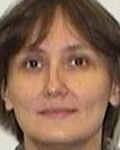Q&A Offers Additional Funding Insight
To strengthen the connection between the statistical community and National Science Foundation, we continue the series introduced in the May 2023 issue of Amstat News that poses questions to NSF program officers and awardees. If you have questions or comments for the program officers, send them to ASA Director of Science Policy Steve Pierson.
NSF Statistics Program Directors

Yulia Gel

Yong Zeng

Jun Zhu
NSF Statistics Program Directors Yulia Gel, Yong Zeng, and Jun Zhu collectively responded to the following questions. Zeng, from the University of Missouri-Kansas City, is a second-year permanent program director of the Division of Mathematical Sciences in the NSF Directorate for Physical and Mathematical Sciences. Gel, from The University of Texas at Dallas, and Zhu, from the University of Wisconsin-Madison, are in their third and second years, respectively, as rotator program directors of the statistics program. Zeng served in the Division of Mathematical Sciences from 2015–2018 and 2019–2021.
How can researchers from different universities work together on a project and jointly submit a research proposal to NSF?
NSF offers a means called “Collaborative Proposals” to allow investigators from two or more organizations to collaborate on a unified research project. NSF provides two methods for collaborative research proposals to be submitted. One is to request a single award with subawards to the non-lead organization(s) administered by the lead organization. The other is that different organizations, where one is lead and the other non-lead, simultaneously submit proposals, each requesting a separate award. All collaborative proposals must clearly describe the roles to be played by all organizations, specify the managerial arrangements, and explain the advantages of the multi-organizational effort within the project description.
More information can be found in the NSF Proposal & Award Policies & Procedure Guide, Chapter II: Proposal Preparation Instructions, Section E.3. Below are excerpts providing synopses of each method:
- Submission of a collaborative proposal from one organization. The single proposal method allows investigators from two or more organizations who have developed an integrated research project to submit a single, focused proposal. A single investigator is primarily responsible for the administration of the award and discussions with NSF, and, at the discretion of the organizations involved, investigators from any participating organizations may be designated as co-PIs.
- Submission of a collaborative proposal from multiple organizations. Simultaneous submission of proposals allows multiple organizations to submit a unified set of certain proposal sections, as well as information unique to each organization as specified below. All collaborative proposals arranged as separate submissions from multiple organizations must be submitted via Research.gov. For these proposals, the project title must begin with the words “Collaborative Research.”
NSF Awardee
Jessi Cisewski-Kehe is an assistant professor in the department of statistics at the University of Wisconsin-Madison. She completed her PhD in statistics from The University of North Carolina at Chapel Hill, and then joined the department of statistics at Carnegie Mellon University followed by the department of statistics and data science at Yale University. Her primary research interests are astrostatistics and topological data analysis.
Cisewski-Kehe has received funds through the NSF Astronomy and Astrophysics Research Grants program and submitted NSF proposals to a variety of programs as a PI and co-PI. She also participated on an NSF selection panel.
What NSF non-DMS entity funded or contributed, and how will funding be used?
Unmasking Stellar Variability: Hierarchical Bayesian Methods for Characterization of Low-Mass Planets with EPRV Spectroscopy is funded by the NSF’s Division of Astronomical Sciences with the goal of developing statistical methodology to detect and characterize low-mass exoplanets (such as Earth analogs) in the presence of stellar variability. Eric Ford of Penn State is the co-PI; Lily Zhao of the Center for Computational Astrophysics is a collaborator; and Joseph Salzer of the University of Wisconsin-Madison is a statistics PhD student involved in the research. This three-year grant is funded for $511,163, which primarily covers tuition and a stipend for a statistics PhD student and astronomy PhD student.
What will this proposal accomplish?
The radial velocity method is one of the most successful approaches for detecting exoplanets and seeks to detect the movement of a star due to any possible orbiting planets. All else equal, a more massive orbiting planet produces a bigger wobble and stronger signal, making it easier to detect. However, the goal is to uncover the population of low-mass exoplanets such as Earth analogs. The newest generation of spectrographs can uncover tiny signals left by these desirable low-mass exoplanets. However, the instruments are also sensitive to sources of variability in the atmosphere of stars, which can produce time-varying signals that hide or mimic planetary signals and lead to missed or false detections. We are developing statistical modeling techniques to overcome the non-planetary sources of stellar variability to obtain clean radial velocity estimates.
If an NSF non-DMS entity partially or fully funded the award, describe your approach to that entity so others might learn from it.
This award is funded by the NSF’s Division of Astronomical Sciences. When submitting proposals to a non-DMS entity, it helps to focus the goals and results on the impact of the relevant scientific domain and to have close domain collaborators join the proposal. I am fortunate to have long-term astronomy collaborators who contributed their expertise to the writing of the proposal and execution of the research goals.
What advice do you have for others applying for NSF funding?
Get started writing right away, as it takes longer than you might expect. Make sure your research aims, goals, and explanations are clear and understandable to the likely reviewers. If the reviewers do not understand your plans, they are unlikely to give your proposal high ratings. Be sure to emphasize why your proposed research is important and relevant.
It is OK if your proposal is not funded. You can make updates based on the feedback from the reviewers and program officer and resubmit to a future program. Under many circumstances, it can be easier to update a rejected proposal than write a new one from scratch.



















Leave your response!